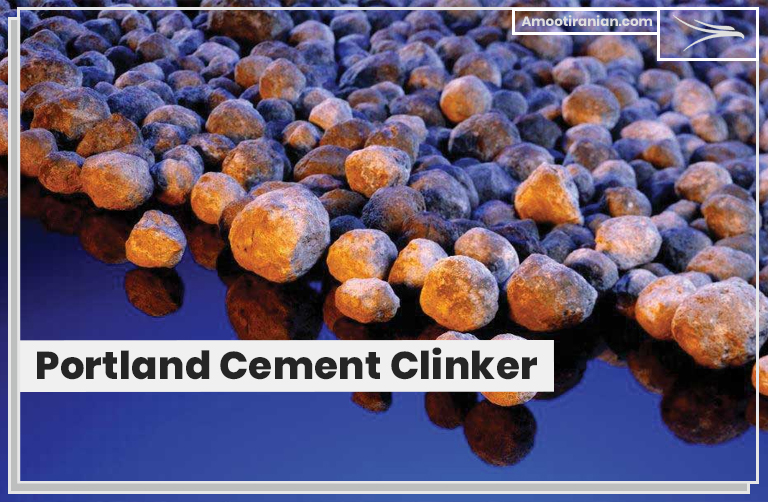.

.
The cement clinker is a dark grey nodular material produced through heating the ground limestone and clay at a temperature range of 1400-1500 degrees of centigrade. The produced nodules are ground up to a fine powder to produce cement, with a small amount of gypsum included to control the properties.
Nodules consist of a sixe range in 1-25mm or more and they are composed of mainly calcium silicates (70-80%). The strength of concrete is mainly due to the reaction of these calcium silicates with water.
Portland cement is obtained by grinding clinker with only minor amounts of a few other minerals, so its composition does not depart far from that of clinker.
Other cements (i.e. non-Portland cements, for example pozzolanic cements, blast furnace slag cements, limestone cements and masonry cements) contain larger amounts of other minerals and have a much wider composition range.
Although the other potential ingredients may be cheap natural materials, clinker is made in an energy-intensive chemical process – in a kiln – and its production is the main concern of this website.
Between one and two billion tonnes a year of clinker are made world-wide, and the details of its formation are therefore of great economic significance, since no viable alternative ingredients for making cement-like materials currently exist.
Unlike many other thermal products (e.g. aluminium, pig-iron), clinker is a fairly complex mixture of different minerals, and so its production depends on a multi-dimensional control of raw materials and a multi-staged heat treatment.
It has been likened to a “man-made igneous rock”, and an understanding of its structure and chemistry requires the application of many principles of geochemistry.
.
Portland cement clinker contains four principal minerals
- Alite (tricalcium silicate typically 65% of the total)
- Belite (dicalcium silicate typically 15% of the total)
- Aluminate (tricalcium aluminate typically 7% of the total)
- Ferrite (tetracalcium aluminoferrite typically 8% of the total)
.
The balance is made up of alkali sulfates and minor impurities. The typical mineral contents shown are subject to wide variation.
.
Clinker Composition
.
In cement chemistry, chemical analyses are normally given in oxide form – a typical example of an analysis follows:
.
| Typical clinker analysis (oxide weight%). | ||||||||||
| SiO2 | Al2O3 | Fe2O3 | CaO | MgO | K2O | Na2O | SO3 | LOI | IR | Total |
| 21.5 | 5.2 | 2.8 | 66.6 | 1.0 | 0.6 | 0.2 | 1.0 | 1.5 | 0.5 | 98.9 |
| Free lime = 1.0% CaO
Balance is typically due to small amounts of oxides of titanium, manganese, phosphorus and chromium. | ||||||||||
.
Clinker produced by early static kilns was in the form of large pumice-like lumps. Rotary kiln clinker on the other hand, because of the rolling action of the kiln, emerges as fairly regular roughly spherical hard nodules of diameter typically 5-50 mm, together with a certain amount of dust abraded from the nodule surfaces.
.
Clinker minerals react with water to produce the hydrates that are responsible for cement’s setting and strength-giving properties. Reaction with water occurs only at the surface of the clinker particle, and so only proceeds rapidly if the clinker is finely ground to produce a large reaction surface.
Un-ground clinker, when exposed to humid air, is hydrated only very gradually, and clinker can be kept in a dry place for several months without appreciable deterioration. It can also be transported from one plant to another in ordinary bulk ships and vehicles, and is traded internationally.
Due to its nearly spherical particles, clinker has excellent flow characteristics. Clinker delivered from above naturally produces neat conical piles with a slope angle of about 37°. Because of this, gravity can be used to produce a high degree of blending. On extracting clinker from below a conical pile, “rat-holing” takes place, producing a uniform blend of the variable layers of clinker laid down during the building of the pile.
In practice, this is effective for blending out both short-term and medium-term variations. Of course, a minimum of two piles or silos is required for this. If a single silo is used, fresh clinker simply “rat-holes” straight through the silo, and no blending occurs. For a modern 1.5 million tons per year plant, two silos of about 30 m diameter are required.
.
Cement and clinker are not the same. Cement is a binding material used in construction whereas clinker is primarily used to produce cement.
The main differences between clinker and cement are given below.
- Clinker is a nodular material which is used as the binder in cement products. Whereas Cement is a binding agent that sets and hardens to adhere to building units such as stones, bricks, tiles etc.
- Clinker is a granular substance containing spherical pellets of diameter 3-25 mm. Cement is such a fine powdery substance that each pound of cement contains 150 billion grains.
- Clinker is produced during the cement manufacturing process inside the kiln. Then raw mix is heated and cooled rapidly to form marble-sized pellets which are clinker. Grinding clinker with different active ingredients depending of the desired cement properties until reaching a fine powder is how cement is produced.
- The composition of a typical good quality clinker for general use: 37-72% of 3CaO.SiO2; 6-47% 2CaO.SiO2; 2-20% 2CaO.Al2O3; 2-19% 4CaO. Al2O3.Fe2O3 and most common type of cement consists of 85% clinker, 1.5-3.5% gypsum by SO3content, and up to 15% admixtures.
- Cement is used in construction to make concrete as well as mortar and to secure the infrastructure by binding the building blocks. It is also used for water-proofing, filling or sealing gaps, and making decorative patterns. The primary use of clinker is to manufacture cement.
